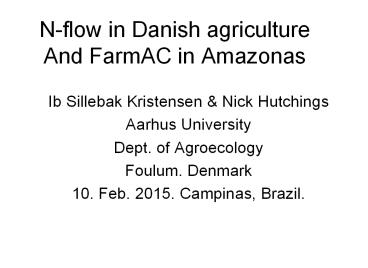N-flow%20in%20Danish%20agriculture%20And%20FarmAC%20in%20Amazonas - PowerPoint PPT Presentation
Title:
N-flow%20in%20Danish%20agriculture%20And%20FarmAC%20in%20Amazonas
Description:
N-flow in Danish agriculture And FarmAC in Amazonas Ib Sillebak Kristensen & Nick Hutchings Aarhus University Dept. of Agroecology Foulum. Denmark – PowerPoint PPT presentation
Number of Views:154
Avg rating:3.0/5.0
Title: N-flow%20in%20Danish%20agriculture%20And%20FarmAC%20in%20Amazonas
1
N-flow in Danish agricultureAnd FarmAC in
Amazonas
- Ib Sillebak Kristensen Nick Hutchings
- Aarhus University
- Dept. of Agroecology
- Foulum. Denmark
- 10. Feb. 2015. Campinas, Brazil.
2
part 1
- Principles for Nutrient flows, examplified on
average - DK agriculture
3
Farm N balance N-leaching
Hansen et al. Env Sci. Tech. (2011)
4
N-eff. in Danish Agriculture
5
Danish Farm N surplusDevelopment and Variation
2008
1990
Dalgaard et al. BiogeoSciences 9 (2012)
6
N-flow on 4 organic dairy farms in Estonia in 1998
75N/cow in manure from stable
7
(No Transcript)
8
- DK agriculture N-balance, 1999
- Input Kg N ha-1 year-1
- N-fertiliser 94
- Seed 2
- Fodder 79
- N-fixation 13
- Precipitation 16
- Output
- Milk -9
- Animals -28
- Cash crops -41
- los in .
-
-stall -storage fieldbalance - N-surplus 125 - 9 -4 112
9
Field-balance Un-secure
Farm-balance Reliable
10
(No Transcript)
11
- N-losses in DK-agriculture, 1999
- Kg N ha-1 year-1
N-los of input - Farm gate N-surplus 125
- Amm. los in
- Stall -9 9
- Storage -4 4
- Field N-surplus 112
- Amm. los
- Spreading -8 11
- Grazing -1 7
- Fertiliser -5 3
- Crops -4 4
- Denitrifikation -16 11
- Change in soil-N 0
- N-leaching (difference) - 78
12
Dairy conv.
Pig conv.
Dairy organic
Arable organic
Arable conv.
13
(No Transcript)
14
(No Transcript)
15
FarmAC model the basics
16
FarmAC model
- Focusses on livestock farming systems
- Can be used for arable agriculture
- Intended to have wide applicability
- Simple enough that demand for inputs and
parameters is manageable - Complex enough to describe consequences of
mitigation/adaptation measures - Mass flow for C and N
- Consistency between GHG and N emissions
- Capture knock-on effects
17
(No Transcript)
18
(No Transcript)
19
Components
- Cattle model (simplified Australian)
- energy and protein determine growth/milk
- Animal housing and manure storage (mainly IPCC)
- Crop model
- Potential growth N limitation water
limitation - Soil model
- simple soil water model
- simple soil C and N model
20
How the model sees grain crops
21
How the model sees forage crops
22
Enough production
More than enough production
23
What the cattle thinks they can eat
What the pasture can supply
Not enough production
24
Running FarmAC (1)
- Define crop sequences
- area, soil type, irrigation
- crop sequence (crops and bare soil)
- Define yield potentials and grazed yields
- also define fate of crop residues
- Define livestock numbers, feed rations, livestock
housing and manure storage - calculates manure production
- calculates livestock production
- Decide manure and fertiliser applications
25
Running FarmAC (2)
- Simulate!
- What can go wrong
- grazed yield cannot be achieved
- total production of grazed forage does not equal
total consumption of grazed forage
26
Yield modelling
- Potential yield (water and N unlimited)
- for all crop products
- input by users
- Calculate water-limited yield (Water balance)
- Calculate N uptake at water-limited yield
- includes N in above and below-ground crop
residues - Calculate mineral N available
- Mineral N or maximum uptake determines yield
27
Calculating mineral N available
- Mineral N mineral N input - losses
- N inputs
- atmosphere
- N fixation
- fertiliser
- manure
- urine
- mineralised soil, manure organic N, dung and crop
residue N
28
Calculating mineral N available
- N outputs
- Ammonia emission, which varies between
- fertiliser, manure, urine
- application method
- N2O and N2 emission
- N2O via emission factor (varies between sources)
- N2 N2O factor
- N leaching, which varies with
- timing of application of fertiliser/manure
- Period with drainage
29
Growth
- Potential crop N uptake crop N uptake with
water-limited yield - If mineral N available gt potential crop N uptake
- Modelled growth water-limited growth
- Otherwise
- Modelled growth mineral N available/potential
crop N uptake
30
How to define a permanent crop
- The fertilisation necessary to achieve a given
yield will change with time - For grazed crops, the fertilisation will be
determined by the year with the least
mineralisation of soil N - Means that excessive fertiliser will be applied
in other years - Break the permanent crop into several crops
31
Amazonian forest
- Simulated here by teak
- Main features
- no export of products
- deep roots, high rainfall 1000 mm drainage and
high temperature - high CN ration in residues
- N input 10 kg/ha/yr from precipitation
32
Forest
Total soil-C
Slow degradable ½ time life 365 years
degradeble ½ time life 5 year
Quick degradeble ½ time life 1,5 mdr
33
Bare soil
34
Grass no cattle
35
Grass few cattle
36
Grass more cattle
37
N inputs light grazing
38
N outputs light grazing
39
C stored in soil long term
40
Dry matter production long term
41
N inputs long term
42
N outputs long term
43
(No Transcript)
44
Losses are calculated for the whole crop period
45
So it might be sensible to divide the crop in two
46
Soil-C in farm type
47
Soil pools never in equilibrium































